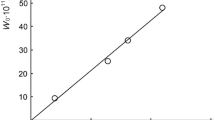Abstract
A parabolic model of the transition state is used for the analysis of experimental data (rate constants and activation energies) for reactions of addition of alkyl and phenyl radicals to multiple bonds of unsaturated compounds. The parameters describing the activation energy as a function of the enthalpy of the reactions were calculated from the experimental data. The activation energy depends also on the strength of the forming C−C bond, the presence of π-bonds in the α-position near the attacked C=C bond and the presence of polar groups in the monomer and radical. The empirical dependence of the activation energy of a thermoneutral addition reactionE e0 on the dissociation energyD e of the forming C−C bond was obtained:E e0=(5.95±0.06)·10−4 D e 2 kJ mol−1, indicating the important role of triplet repulsion in the formation of the transition state of radical addition. The contribution of the polar interaction to the activation energy of addition of polar radicals to polar monomers was calculated.
Similar content being viewed by others
References
N. N. Semenov,Nekotorye problemy khimicheskoi kinetiki i reaktsionnoi sponsobnosti [Some Problems of Chemical Kinetics and Reactivity], Izd. AN SSSR, Moscow, 1958 (in Russian).
C. Walling,Free Radicals in Solution, Chapman and Hall, New York, 1957.
Kh. S. Bagdasar'yan,Teoriya radikal'noi polimerizatsii [Theory of Radical Polymerization], Izd. AN SSSR, Moscow, 1966 (in Russian).
Comprehensive Chemical Kinetics,14A,Free Radical Polymerization, Elsevier Sci. Publ. Co., Amsterdam, 1976.
P. I. Abell,Addition to Multiple Bonds, inFree Radicals,II, Ed. J. K. Kochi, J. Wiley, New York, 1973.
T. Zytowski and H. Fischer,J. Am. Chem. Soc., 1996,118, 437.
B. Giese,Radicals in Organic Synthesis: Formation of Carbon—Carbon Bonds, Pergamon Press, Oxford, 1986.
E. T. Denisov,Usp. Khim., 1997,66, 953 [Russ. Chem. Rev., 1997,66, 859 (Engl. Transl.)].
E. T. Denisov,Kinet. Katal., 1994,35, 671 [Kinet. Catal., 1994,35, 614 (Engl. Transl.)].
E. T. Denisov,Kinet. Katal., 1992,33, 66 [Kinet. Catal., 1992,33 (Engl. Transl.)].
NIST Standard Reference Database 17 NIST Chemical Kinetics Database—Version 6.0, Gaithersburg, 1994.
E. T. Denisov,Zh. Fiz. Khim., 1975,49, 2473 [J. Phys. Chem. USSR, 1975,49 (Engl. Transl.)].
W. Tsang,Heats of Formation of Organic Free Radicals by Kinetic Methods inEnergetics of Free Radicals, Eds. A. Greenberg and J. Liebman, Blackie Academic and Professional, New York, 1996, 22.
NIST Standard Reference Database 19A, Positive Ion Energetics, Version 2.02, Gaithersburg, 1994.
E. T. Denisov,Zh. Fiz. Khim., 1993,67, 2416 [Russ. J. Phys. Chem., 1993,67 (Engl. Transl.)].
M. Gazith and M. Szwarc,J. Am. Chem. Soc., 1957,79, 3339.
R. P. Buckley and M. M. Szwarc,J. Am. Chem. Soc., 1956,78, 5696.
J. Gresser, A. Rajbenbach and M. Szwarc,J. Am. Chem. Soc., 1961,83, 3005.
A. R. Bader, R. P. Buckley, F. Leavit and M. Szwarc,J. Am. Chem. Soc., 1957,79, 5621.
R. P. Buckley, F. Leavit and M. Szwarc,J. Am. Chem. Soc., 1956,78, 5557.
V. P. Sass and S. I. Serov,Zh. Org. Khim., 1977,13, 2298. [J. Org. Chem. (USSR), 1977,13 (Engl. Transl.)].
B. C. Gilbert, J. R. Lindsay Smith, E. C. Milne, A. C. Whitwood and P. Taylor,J. Chem. Soc., Perkin Trans., 2, 1993, 2025.
L. Herk, A. Stefani and M. Szwarc,J. Am. Chem. Soc., 1961,83, 3008.
A. Rajbenbach and M. Szwarc,J. Am. Chem. Soc., 1957,79, 6343.
J. Smid and M. Szwarc,J. Am. Chem. Soc., 1957,79, 1534.
K. Munger and H. Fischer,Int. J. Chem. Kinet., 1985,17, 809.
Ya. A. Levin, A. G. Abul'khanov, V. P. Nefedov, M. S. Skorobogatova, and B. E. Ivanov,Dokl. Akad. Nauk SSSR, 1977,235, 629 [Dokl. Chem., 1977 (Engl. Transl.)].
R. F. Bridger and G. A. Russel,J. Am. Chem. Soc., 1963,85, 3754.
E. T. Denisov,Khim. Fiz., 1998,17, 56 [Russ. Chem. Phys., 1998,17 (Engl. Transl.)].
K. Heberger and H. Fischer,Int. J. Chem. Kinet., 1993,25, 249.
K. Heberger and H. Fischer,Int. J. Chem. Kinet., 1993,25, 913.
J. O. Wu, I. Beranek and H. Fischer,Helv. Chim. Acta, 1995,78, 194.
Author information
Authors and Affiliations
Additional information
Translated fromIzvestiya Akademii Nauk. Seriya Khimicheskaya, No. 3, pp. 445–450, March, 1999.
Rights and permissions
About this article
Cite this article
Denisov, E.T. Physical factors determining the activation energy of alkyl radical addition to unsaturated compounds. Russ Chem Bull 48, 442–447 (1999). https://doi.org/10.1007/BF02496158
Received:
Issue Date:
DOI: https://doi.org/10.1007/BF02496158




